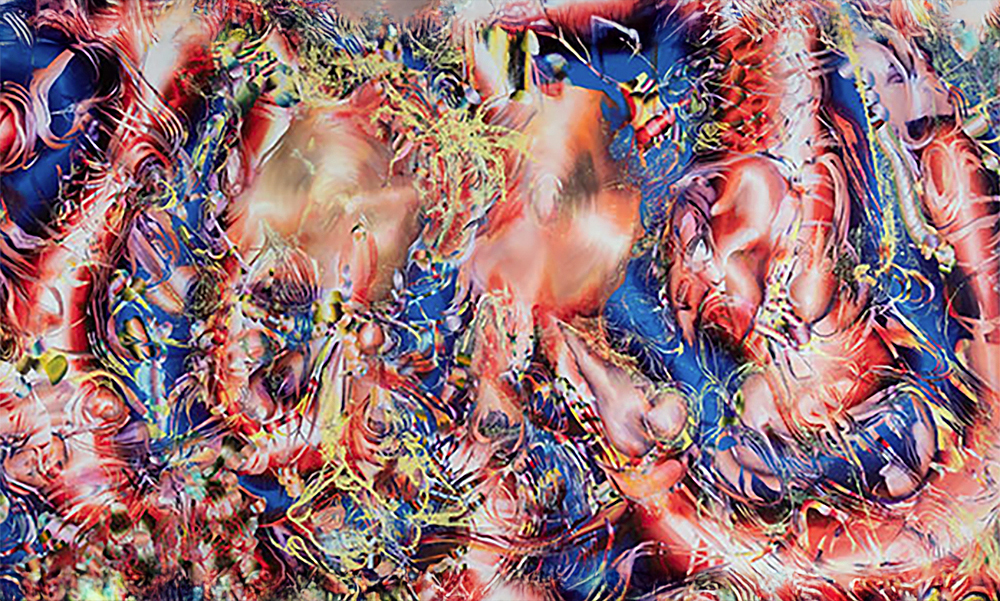Lauren Quin: My Hellmouth 2023
On view Jan. 21 to June 18, 2023
Nerman Museum of Contemporary Art is pleased to announce My Hellmouth, Los Angeles-based artist Lauren Quin’s premiere solo museum exhibition. Presented within the Cohen and Lieberman Galleries, this exhibition will showcase new paintings by the artist. In tandem, NMOCA will release Quin’s first comprehensive monographic publication, featuring a director’s foreword by JoAnne Northrup, an essay by Fanny Singer, and an interview with the artist by Sarah Lehrer-Graiwer.
I wish that I could write the way that Lauren Quin paints. If only a sentence could be as sprightly, spontaneous, and quick-witted as her mark-making—if only a paragraph could unfurl an argument as dense and dazzling as any square foot of her canvases. How to craft an essay that could expand and contract its scale, attend to both the infinitesimal and the infinite, the microscopic and the monumental? How to fold in one’s forebears and yet whip up something so entirely fresh?
I don’t have the answers. Painterly abstraction like Quin’s was, after all, first founded on the imperative of expressing the inexpressible; after two world wars, words were failing everyone. Of course, many movements, conflicts, and trends—artistic, political, and global—have since come and gone, but a fundamental truth has not budged: that abstract painting, as the historian T.J. Clark has stated, “does not go elsewhere for its language.” [1] While the old French salons were known for stirring up brassy debates, our very American Abstract Expressionism pleaded for quiet on the set, doing its best to shut out any and all semiotic chatter. Generations later, contemplative silence remains de rigeur, and light-footed critique a pervasive norm.
By comparison, My Hellmouth at the Nerman Museum seems to throw open the windows and let out a womanly scream. That title, in tandem with the Los Angeles–based painter’s glowing, churning canvases, implies an inferno of activity, things swallowed up and spit back out. Invigorated—truly—after first seeing the paintings in person, I had half a mind to write this essay in all-caps letters, hollering it out in Jenny Holzer-esque dictums, or by collaging some bold-faced, cut-up wisdom à la Barbara Kruger.
This impulse might have also been primed by Quin’s recent exhibition at Blum & Poe in Los Angeles, my first in-person encounter with her paintings. It ran alongside a suite of new sculptures by the famed artist and agitator Lynda Benglis; Quin tributed her neighbor with To Lynda, a 15-foot-wide composition of swirling, incandescent reds and blues. She also titled the show Pulse Train Howl, again invoking a guttural speech act.
I haven’t been able to get these feminist art ancestors off my mind since. It’s not that Quin’s work makes an express stance; what an unsubtle tragedy that would be. But her jewel-toned blizzards of brushing, scraping, drawing, and printing, all layered atop one another, coursing and splashing through a system of her own invention, speak of some excess of feminine energy, exploding and imploding before our eyes. Howl, and My Hellmouth; Quin’s paintings cry out something that can’t be put into words. I can’t help but identify my own tendencies toward nervous excitement, the casual, pushed-down terror of being a woman in the world, the exuberance and luminance that is so often expected of us.
I first met, and bonded with, Quin in a gallery parking lot, where I had just participated in a reading. I recited a story about my digestive tract: throat, to intestines, all the way to the asshole—the other “hellmouth,” one could say—which has been plagued since puberty with chronic inflammation and pain. The affliction was dubbed Crohn’s Disease, and remains eternally entwined with my psyche, with stress, with that aforementioned, unspeakable feminine fear. It’s impossible not to be reminded of my own bowels when looking at Quin’s own twisting and turning tubes. The smaller, tricolor dabs on the top layer of her paintings cluster like red blood cells, tending to the rupture and chaos. Thinner lines, added with the trace monotype method, tear across the softer tissue of her shimmering colors, cutting loose outlines of what look like legs, torsos, buttocks. The body, and all its intricacies, keeping the score. What the late Lauren Berlant called the “disordered forms” of life and art, “gestures of partial efficacy disturbed”[2] by illness, emotion, and the general entropy of existence.
Quin’s work speaks in ways that transcend the confines of speech, like all great feminism does. And it has crafted its own painterly grammar and syntax, like all great painting does. In an essay on Valerie Solanas’s SCUM Manifesto, the take-no-prisoners feminist treatise in which its author found herself “disabled by the very fact of language,” the feminist scholar Avital Ronell emphasized the power of wordless expression, invoking the Heideggerian idea of the “inscribing/cry—the schreiben/schrei, cri/écrit or gritto/escrito.”[3] In these cousins of English, mark-making and noise-making—howling, say—are one and the same. Are Quin’s cacophonies on canvas, therefore, colorful crying-outs? Are they joyful elegies or angered rants? Her own manifestos of top-secret meaning? Again, I don’t have the answers. But I agree with Ronell: “sometimes,” she declares, “you have to scream to be heard.”
—Juliana Halpert
Lauren Quin lives and works in Los Angeles, CA. She holds an MFA from the Yale School of Art, New Haven, CT and a BFA from the School of the Art Institute of Chicago, Chicago, IL. Her work is represented in numerous public collections including the Fine Arts Museum of San Francisco, San Francisco, CA; High Museum of Art, Atlanta, GA; ICA Miami, Miami, FL; Pérez Art Museum, Miami, FL; Phoenix Art Museum, Phoenix, AZ; and Walker Art Center, Minneapolis, MN.
[1] Clark, T.J. “In Defense of Abstract Expressionism,” October, 69, no. 4 (Summer 1994): 30.
[2] Berlant, Lauren. “The Undying.” 4Columns. Accessed October 27, 2022. https://4columns.org/berlant-lauren/the-undying.
[3] Ronell, Avital. “Deviant Payback: The Aims of Valerie Solanas.” In Solanas, Valerie, SCUM Manifesto, (New York: Verso, 2015), Retrieved from https://www.lapl.org/.


